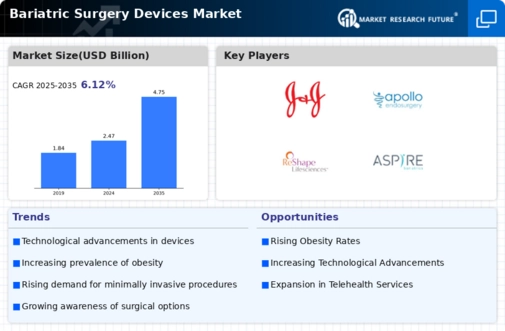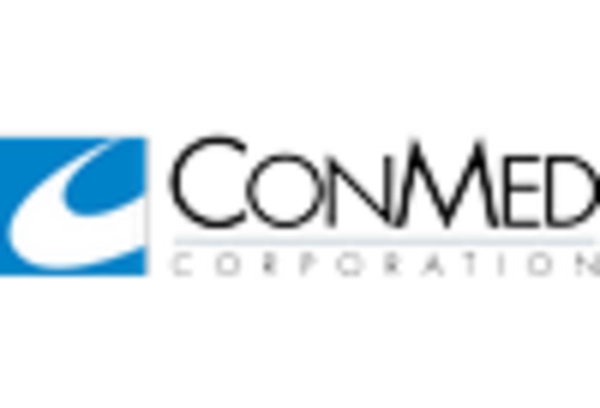-
EXECUTIVE SUMMARY
-
OVERVIEW 15
- MARKET SYNOPSIS 15
-
MARKET INTRODUCTION
-
SCOPE OF THE STUDY 16
-
RESEARCH OBJECTIVE 16
-
LIST OF ASSUMPTIONS 17
-
RESEARCH METHODOLOGY
-
OVERVIEW 18
-
DATA MINING 18
-
SECONDARY RESEARCH 19
-
PRIMARY RESEARCH 20
- PRIMARY INTERVIEWS AND INFORMATION GATHERING PROCESS 20
- BREAKDOWN OF PRIMARY RESPONDENTS 21
-
FORECASTING TECHNIQUES 21
-
RESEARCH METHODOLOGY FOR MARKET SIZE ESTIMATION 22
- BOTTOM-UP APPROACH 23
- TOP-DOWN APPROACH 24
-
DATA TRIANGULATION 24
-
VALIDATION 25
-
MARKET DYNAMICS
-
OVERVIEW 26
-
DRIVERS 27
- INCREASING PREVALENCE OF OBESITY 27
- RISING TECHNOLOGICAL ADVANCEMENTS 27
- GROWING NUMBER OF BARIATRIC AND METABOLIC SURGERIES 27
- INCREASING NUMBER OF REGULATORY APPROVALS FOR BARIATRIC SURGERY DEVICES 27
-
RESTRAINTS 28
- RISING PRODUCT RECALLS IN THE INDUSTRY 28
- HIGH COST OF BARIATRIC SURGERIES 28
-
OPPORTUNITIES 29
- EMERGING MARKETS WITH HIGH PREVALENCE OF OBESITY 29
-
MARKET FACTOR ANALYSIS
-
PORTER’S FIVE FORCES MODEL 30
- THREAT OF NEW ENTRANTS 30
- BARGAINING POWER OF SUPPLIERS 31
- THREAT OF SUBSTITUTES 31
- BARGAINING POWER OF BUYERS 31
- INTENSITY OF RIVALRY 31
-
SUPPLY CHAIN ANALYSIS 32
- R&D AND DESIGNING 33
- MANUFACTURING 33
- DISTRIBUTION 33
- MARKETING & SALES 33
- POST-SALES MONITORING 33
-
RECENT FDA APPROVALS 34
-
BARIATRIC SURGERY DEVICES MARKET, BY TYPE
-
OVERVIEW 35
-
MINIMALLY INVASIVE SURGICAL DEVICES 36
- STAPLING DEVICES 37
- ENERGY/VESSEL SEALING DEVICES 37
- SUTURING DEVICES 38
- ACCESSORIES 38
-
NON-INVASIVE SURGICAL DEVICES 39
-
BARIATRIC SURGERY DEVICES MARKET, BY PROCEDURE
-
OVERVIEW 40
-
SLEEVE GASTRECTOMY 42
-
GASTRIC BYPASS 42
-
REVISION SURGERY 43
-
ADJUSTABLE GASTRIC BAND 43
-
OTHERS 44
-
BARIATRIC SURGERY DEVICES MARKET, BY END USER
-
OVERVIEW 45
-
HOSPITALS 46
-
SPECIALTY CENTRES 46
-
AMBULATORY SURGICAL CENTERS 47
-
OTHERS 47
-
GLOBAL BARIATRIC SURGERY DEVICES MARKET, BY REGION
-
OVERVIEW 48
-
AMERICAS 49
-
BARIATRIC SURGERY DEVICES MARKET, BY TYPE
-
BARIATRIC SURGERY DEVICES MARKET, BY PROCEDURE
-
BARIATRIC SURGERY DEVICES MARKET, BY END USER
-
NORTH AMERICA 51
-
BARIATRIC SURGERY DEVICES MARKET, BY TYPE
-
BARIATRIC SURGERY DEVICES MARKET, BY PROCEDURE
-
BARIATRIC SURGERY DEVICES MARKET, BY END USER
-
US 52
-
BARIATRIC SURGERY DEVICES MARKET, BY TYPE
-
BARIATRIC SURGERY DEVICES MARKET, BY PROCEDURE
-
BARIATRIC SURGERY DEVICES MARKET, BY END USER
-
CANADA 54
-
BARIATRIC SURGERY DEVICES MARKET, BY TYPE
-
BARIATRIC SURGERY DEVICES MARKET, BY PROCEDURE
-
BARIATRIC SURGERY DEVICES MARKET, BY END USER
-
LATIN AMERICA 55
-
BARIATRIC SURGERY DEVICES MARKET, BY TYPE
-
BARIATRIC SURGERY DEVICES MARKET, BY PROCEDURE
-
BARIATRIC SURGERY DEVICES MARKET, BY END USER
-
EUROPE 57
-
BARIATRIC SURGERY DEVICES MARKET, BY TYPE
-
BARIATRIC SURGERY DEVICES MARKET, BY PROCEDURE
-
BARIATRIC SURGERY DEVICES MARKET, BY END USER
-
WESTERN EUROPE 59
-
BARIATRIC SURGERY DEVICES MARKET, BY TYPE
-
BARIATRIC SURGERY DEVICES MARKET, BY PROCEDURE
-
BARIATRIC SURGERY DEVICES MARKET, BY END USER
-
GERMANY 61
-
BARIATRIC SURGERY DEVICES MARKET, BY TYPE
-
BARIATRIC SURGERY DEVICES MARKET, BY PROCEDURE
-
BARIATRIC SURGERY DEVICES MARKET, BY END USER
-
FRANCE 62
-
BARIATRIC SURGERY DEVICES MARKET, BY TYPE
-
BARIATRIC SURGERY DEVICES MARKET, BY PROCEDURE
-
BARIATRIC SURGERY DEVICES MARKET, BY END USER
-
UK 63
-
BARIATRIC SURGERY DEVICES MARKET, BY TYPE
-
BARIATRIC SURGERY DEVICES MARKET, BY PROCEDURE
-
BARIATRIC SURGERY DEVICES MARKET, BY END USER
-
ITALY 65
-
BARIATRIC SURGERY DEVICES MARKET, BY TYPE
-
BARIATRIC SURGERY DEVICES MARKET, BY PROCEDURE
-
BARIATRIC SURGERY DEVICES MARKET, BY END USER
-
SPAIN 66
-
BARIATRIC SURGERY DEVICES MARKET, BY TYPE
-
BARIATRIC SURGERY DEVICES MARKET, BY PROCEDURE
-
BARIATRIC SURGERY DEVICES MARKET, BY END USER
-
REST OF WESTERN EUROPE 67
-
BARIATRIC SURGERY DEVICES MARKET, BY TYPE
-
BARIATRIC SURGERY DEVICES MARKET, BY PROCEDURE
-
BARIATRIC SURGERY DEVICES MARKET, BY END USER
-
EASTERN EUROPE 69
-
BARIATRIC SURGERY DEVICES MARKET, BY TYPE
-
BARIATRIC SURGERY DEVICES MARKET, BY PROCEDURE
-
BARIATRIC SURGERY DEVICES MARKET, BY END USER
-
ASIA-PACIFIC 71
-
BARIATRIC SURGERY DEVICES MARKET, BY TYPE
-
BARIATRIC SURGERY DEVICES MARKET, BY PROCEDURE
-
BARIATRIC SURGERY DEVICES MARKET, BY END USER
-
JAPAN 73
-
BARIATRIC SURGERY DEVICES MARKET, BY TYPE
-
BARIATRIC SURGERY DEVICES MARKET, BY PROCEDURE
-
BARIATRIC SURGERY DEVICES MARKET, BY END USER
-
CHINA 74
-
BARIATRIC SURGERY DEVICES MARKET, BY TYPE
-
BARIATRIC SURGERY DEVICES MARKET, BY PROCEDURE
-
BARIATRIC SURGERY DEVICES MARKET, BY END USER
-
INDIA 76
-
BARIATRIC SURGERY DEVICES MARKET, BY TYPE
-
BARIATRIC SURGERY DEVICES MARKET, BY PROCEDURE
-
BARIATRIC SURGERY DEVICES MARKET, BY END USER
-
AUSTRALIA 77
-
BARIATRIC SURGERY DEVICES MARKET, BY TYPE
-
BARIATRIC SURGERY DEVICES MARKET, BY PROCEDURE
-
BARIATRIC SURGERY DEVICES MARKET, BY END USER
-
SOUTH KOREA 78
-
BARIATRIC SURGERY DEVICES MARKET, BY TYPE
-
BARIATRIC SURGERY DEVICES MARKET, BY PROCEDURE
-
BARIATRIC SURGERY DEVICES MARKET, BY END USER
-
REST OF ASIA-PACIFIC 80
-
BARIATRIC SURGERY DEVICES MARKET, BY TYPE
-
BARIATRIC SURGERY DEVICES MARKET, BY PROCEDURE
-
BARIATRIC SURGERY DEVICES MARKET, BY END USER
-
MIDDLE EAST & AFRICA 82
-
BARIATRIC SURGERY DEVICES MARKET, BY TYPE
-
BARIATRIC SURGERY DEVICES MARKET, BY PROCEDURE
-
BARIATRIC SURGERY DEVICES MARKET, BY END USER
-
MIDDLE EAST 84
-
BARIATRIC SURGERY DEVICES MARKET, BY TYPE
-
BARIATRIC SURGERY DEVICES MARKET, BY PROCEDURE
-
BARIATRIC SURGERY DEVICES MARKET, BY END USER
-
AFRICA 85
-
BARIATRIC SURGERY DEVICES MARKET, BY TYPE
-
BARIATRIC SURGERY DEVICES MARKET, BY PROCEDURE
-
BARIATRIC SURGERY DEVICES MARKET, BY END USER
-
COMPETITIVE LANDSCAPE
-
OVERVIEW 87
-
COMPETITIVE ANALYSIS 87
-
COMPETITOR DASHBOARD 88
-
COMPETITIVE BENCHMARKING 89
-
MAJOR GROWTH STRATEGY IN THE GLOBAL BARIATRIC SURGERY DEVICES MARKET 90
-
LEADING PLAYERS IN TERMS OF NUMBER OF DEVELOPMENTS 90
-
KEY DEVELOPMENTS AND GROWTH STRATEGIES 91
- AGREEMENTS 91
- EXPANSIONS 91
- ACQUISITIONS 92
- PRODUCT APPROVALS AND LAUNCHES 92
-
MAJOR PLAYERS FINANCIAL MATRIX & MARKET RATIO 93
- SALES & OPERATING PROFIT MARGIN 93
- R&D EXPENDITURE 94
-
COMPANY PROFILES
-
MEDTRONIC 95
- COMPANY OVERVIEW 95
- FINANCIAL OVERVIEW 96
- PRODUCTS/SERVICES OFFERED 97
- KEY DEVELOPMENTS 97
- SWOT ANALYSIS 99
- KEY STRATEGIES 99
-
APOLLO ENDOSURGERY, INC. 100
- COMPANY OVERVIEW 100
- FINANCIAL OVERVIEW 100
- PRODUCTS/SERVICES OFFERED 101
- KEY DEVELOPMENTS 101
- SWOT ANALYSIS 102
- KEY STRATEGIES 102
-
INTUITIVE SURGICAL INC. 103
- COMPANY OVERVIEW 103
- FINANCIAL OVERVIEW 103
- PRODUCTS/SERVICES OFFERED 104
- KEY DEVELOPMENTS 104
- SWOT ANALYSIS 106
- KEY STRATEGIES 106
-
JOHNSON & JOHNSON SERVICES INC. 107
- COMPANY OVERVIEW 107
- FINANCIAL OVERVIEW 107
- PRODUCTS/SERVICES OFFERED 108
- KEY DEVELOPMENTS 108
- SWOT ANALYSIS 109
- KEY STRATEGIES 109
-
RESHAPE LIFESCIENCES, INC. 110
- COMPANY OVERVIEW 110
- FINANCIAL OVERVIEW 110
- PRODUCTS/SERVICES OFFERED 111
- KEY DEVELOPMENTS 111
- SWOT ANALYSIS 111
- KEY STRATEGIES 111
-
OLYMPUS CORPORATION 112
- COMPANY OVERVIEW 112
- FINANCIAL OVERVIEW 112
- PRODUCTS/SERVICES OFFERED 113
- KEY DEVELOPMENTS 113
- SWOT ANALYSIS 114
- KEY STRATEGIES 114
-
MEDIFLEX SURGICAL PRODUCTS 115
- COMPANY OVERVIEW 115
- FINANCIAL OVERVIEW 115
- PRODUCTS/SERVICES OFFERED 115
- KEY DEVELOPMENTS 115
- SWOT ANALYSIS 116
- KEY STRATEGIES 116
-
TRANSENTERIX SURGICAL, INC. 117
- COMPANY OVERVIEW 117
- FINANCIAL OVERVIEW 117
- PRODUCTS/SERVICES OFFERED 118
- KEY DEVELOPMENTS 118
- SWOT ANALYSIS 118
- KEY STRATEGIES 118
-
ASPIRE BARIATRICS 119
- COMPANY OVERVIEW 119
- FINANCIAL OVERVIEW 119
- PRODUCTS/SERVICES OFFERED 119
- KEY DEVELOPMENTS 119
- SWOT ANALYSIS 120
- KEY STRATEGIES 120
-
SPATZ FGIA, INC. 121
- COMPANY OVERVIEW 121
- FINANCIAL OVERVIEW 121
- PRODUCTS/SERVICES OFFERED 121
- KEY DEVELOPMENTS 121
- SWOT ANALYSIS 122
- KEY STRATEGIES 122
-
APPENDIX
-
REFERENCES 123
-
RELATED REPORTS 123
-
LIST OF TABLES
-
LIST OF ASSUMPTIONS 17
-
GLOBAL BARIATRIC SURGERY DEVICES MARKET, BY TYPE 2020-2027 (USD MILLION) 36
-
GLOBAL BARIATRIC SURGERY DEVICES MARKET, FOR MINIMALLY INVASIVE SURGICAL DEVICES, BY TYPE 2020-2027
-
(USD MILLION) 36
-
GLOBAL BARIATRIC SURGERY DEVICES MARKET, FOR MINIMALLY INVASIVE SURGICAL DEVICES, BY REGION 2020-2027
-
(USD MILLION) 36
-
GLOBAL BARIATRIC SURGERY DEVICES MARKET, FOR STAPLING DEVICES, BY TYPE 2020-2027 (USD MILLION) 37
-
GLOBAL BARIATRIC SURGERY DEVICES MARKET, FOR ENERGY/VESSEL SEALING DEVICES, BY TYPE 2020-2027 (USD MILLION) 37
-
GLOBAL BARIATRIC SURGERY DEVICES MARKET, FOR SUTURING DEVICES, BY TYPE 2020-2027 (USD MILLION) 38
-
GLOBAL BARIATRIC SURGERY DEVICES MARKET, FOR ACCESSORIES, BY TYPE 2020-2027 (USD MILLION) 38
-
GLOBAL BARIATRIC SURGERY DEVICES MARKET, FOR NON-INVASIVE SURGICAL DEVICES, BY REGION 2020-2027 (USD MILLION) 39
-
GLOBAL BARIATRIC SURGERY DEVICES MARKET, BY PROCEDURE 2020-2027 (USD MILLION) 41
-
GLOBAL BARIATRIC SURGERY DEVICES MARKET, FOR SLEEVE GASTRECTOMY, BY REGION 2020-2027 (USD MILLION) 42
-
GLOBAL BARIATRIC SURGERY DEVICES MARKET, FOR GASTRIC BYPASS, BY REGION 2020-2027 (USD MILLION) 42
-
GLOBAL BARIATRIC SURGERY DEVICES MARKET, FOR REVISION SURGERY, BY REGION 2020-2027 (USD MILLION) 43
-
GLOBAL BARIATRIC SURGERY DEVICES MARKET, FOR ADJUSTABLE GASTRIC BAND, BY REGION 2020-2027 (USD MILLION) 43
-
GLOBAL BARIATRIC SURGERY DEVICES MARKET, FOR OTHER PROCEDURES, BY REGION 2020-2027 (USD MILLION) 44
-
GLOBAL BARIATRIC SURGERY DEVICES MARKET, BY END USER 2020-2027 (USD MILLION) 46
-
GLOBAL BARIATRIC SURGERY DEVICES MARKET, FOR HOSPITALS, BY REGION 2020-2027 (USD MILLION) 46
-
GLOBAL BARIATRIC SURGERY DEVICES MARKET, FOR SPECIALTY CENTRES, BY REGION 2020-2027 (USD MILLION) 46
-
GLOBAL BARIATRIC SURGERY DEVICES MARKET, FOR AMBULATORY SURGICAL CENTERS, BY REGION 2020-2027 (USD MILLION) 47
-
GLOBAL BARIATRIC SURGERY DEVICES MARKET, FOR OTHER END USERS, BY REGION 2020-2027 (USD MILLION) 47
-
GLOBAL: BARIATRIC SURGERY DEVICES MARKET, BY REGION, 2020–2027 (USD MILLION) 48
-
AMERICAS: BARIATRIC SURGERY DEVICES MARKET, BY REGION, 2020–2027 (USD MILLION) 49
-
AMERICAS: BARIATRIC SURGERY DEVICES MARKET, BY TYPE, 2020–2027 (USD MILLION) 49
-
AMERICAS: BARIATRIC SURGERY DEVICES MARKET, FOR MINIMALLY INVASIVE SURGICAL DEVICES, BY TYPE 2020-2027
-
(USD MILLION) 50
-
AMERICAS: BARIATRIC SURGERY DEVICES MARKET, BY PROCEDURE, 2020–2027 (USD MILLION) 50
-
AMERICAS: BARIATRIC SURGERY DEVICES MARKET, BY END USER, 2020–2027 (USD MILLION) 50
-
NORTH AMERICA: BARIATRIC SURGERY DEVICES MARKET, BY COUNTRY, 2020–2027 (USD MILLION) 51

















Leave a Comment